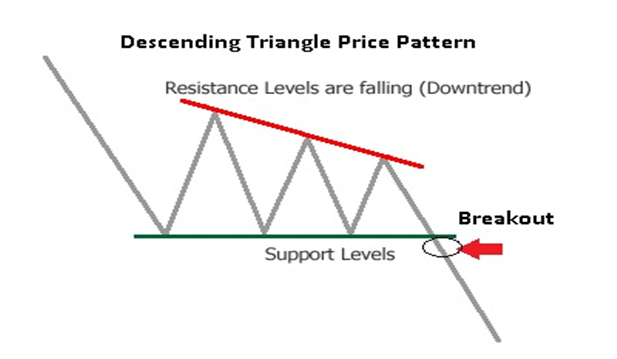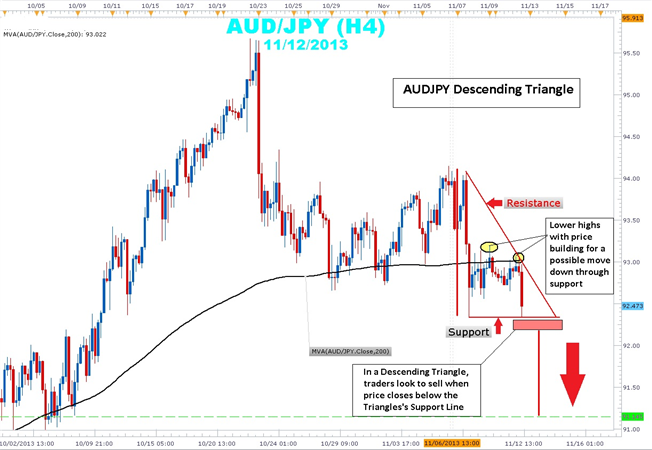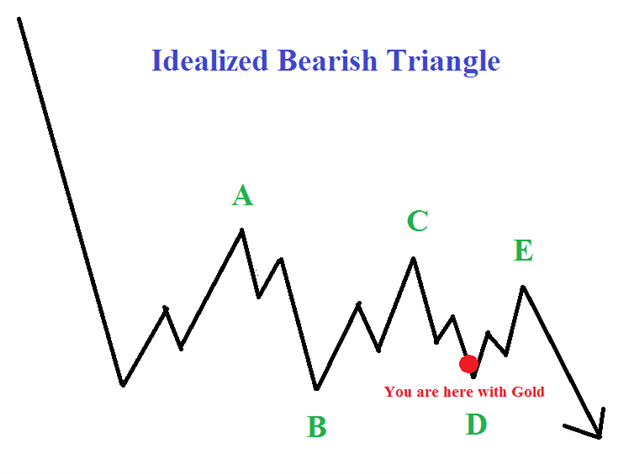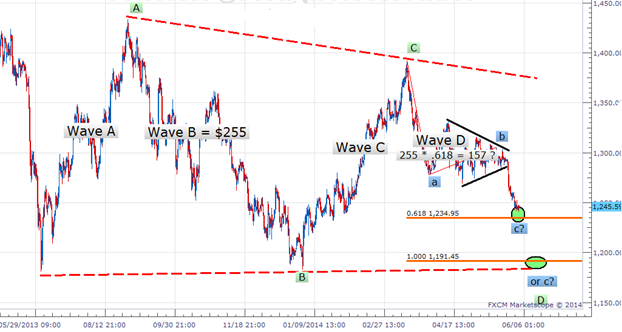How to Trade a Descending Triangle
Talking Points
- Triangle price patterns can be used in Forex trading to identify potential breakout setups
- Descending triangles form when a rising trend line and a horizontal support line converge
- Traders can look for the breakout from the descending triangle to signal the continuation of the AUDJPY down move.

===============
What is a Descending Triangle pattern?
A descending triangle pattern is consolidation price pattern composed of
lower swing highs pushed lower by an established downtrend line
converging with a horizontal support made up of a series of swing lows
located in roughly the same area. Another name for the descending
triangle is the right triangle pattern due to its similarity to the
geometric shape of the same name. The height of the triangle meets the
horizontal support at a 90 degree angle.
Usually, descending triangles form as profit taking by sellers is met
with bargain hunting buyers. However, the buying pressure is mutted as
higher lows are not made. A news release or economic announcement could
be the catalyst required to push price out of this coil tilting the
balance strongly in the seller's favor. Unlike its cousins, the
symmetrical triangle and ascending triangle, the descending lacks
significant bullish participation indicated by that lack of higher lows.
Taking a look at the current AUDJPY 4-hour chart, you can clearly see
price action bound between a descending trend line that connects the
11/6 swing high of 94.15 to 11/12 swing high of 93.05. This swing high
is a lower swing high than the 11/10 93.19 swing high showing the
building strength in the downtrend. Current price action within the
triangle is below the 200 simple moving average (SMA), a key indicator
that traders use to determine bullishness or bearishness.
Traders will watch price action for a 4-hour candle close below support
to confirm that there is follow through in a potential breakout. Stops
can be placed near the middle of the triangle just above the 93.00 and
200 SMA. The height of the triangle is a little over 170 pips. By
extending this height from the support level of a potential breakout
zone, look for a possible target of 91.14. The profit target coincides
with the lows seen back on October 2nd.
In summary, descending triangles can be an excellent way to rejoin a
downtrend that clearly illustrates risk and reward. Price has a tendency
to break form the descending triangle in a downward direction.
Gold Presses Fibonacci Wave Relationship
- Triangles are consolidation patterns that tend provide clean technical levels to trade from
- Gold may be nearing a bullish reaction point that offers a trading opportunity to buy
- Try trading gold in a practice demo account
Look for the yellow metal to find support over the next several days and a potential $100 rise in the price of the gold.
The Anatomy of a Triangle
Triangles are consolidation patterns that allow prices to trade sideways in an effort to alleviate overbought and oversold pressures. In the case of gold, it has been working its way lower for the past three years and needs to consolidate those losses, which it has been doing in the triangle pattern.

Elliott Wave triangles are made up of five waves inside the triangle
with each wave being contained inside the previous wave. In the
idealized example above, notice how wave ‘B’ ends BEFORE the beginning
of wave ‘A’. Notice how wave ‘C’ ends BEFORE the beginning of wave ‘B’.
This continues until prices squeeze together in five waves (A-B-C-D-E)
then they eventually explode.
In the same idealized example above, it appears gold is closing in on
the end of the ‘D’ wave which should yield a bounce higher in wave ‘E’.

wave ending near $1235 per ounce. Both wave relationships are expressed
through alternating waves having a fibonacci relationship in length.
First, inside the green ‘D’ wave, you’ll see we have a blue a-b-c
sequence. Many times, the length of wave ‘c’ will have an equality or
fibonacci relationship to the length of wave ‘a’. In the case for gold,
the length of blue wave ‘c’ equals blue wave ‘a’ times 61.8% at $1235
per ounce.
Secondly, green wave ‘B’ and green wave ‘D’ are alternating waves. If
you take the distance of green wave ‘B’ and multiply it by 61.8% and
project it for a distance on green wave ‘D’, it yields a price target of
$1235 per ounce.
So we have two different alternating waves pointing to the same price
target. This means there will likely be a reaction higher near $1235. If
$1235 does fail, look to $1190-$1200 providing significant support.
The price target to the upside in this scenario would be $1340-$1390. So
there is enough room to the upside to position towards the long side of
the trade.
- Free trading apps
- Over 8,000 signals for copying
- Economic news for exploring financial markets
You agree to website policy and terms of use
Levels:
Another version of the indicator that calculates support/resistance levels.
Author: Nikolay Kositsin